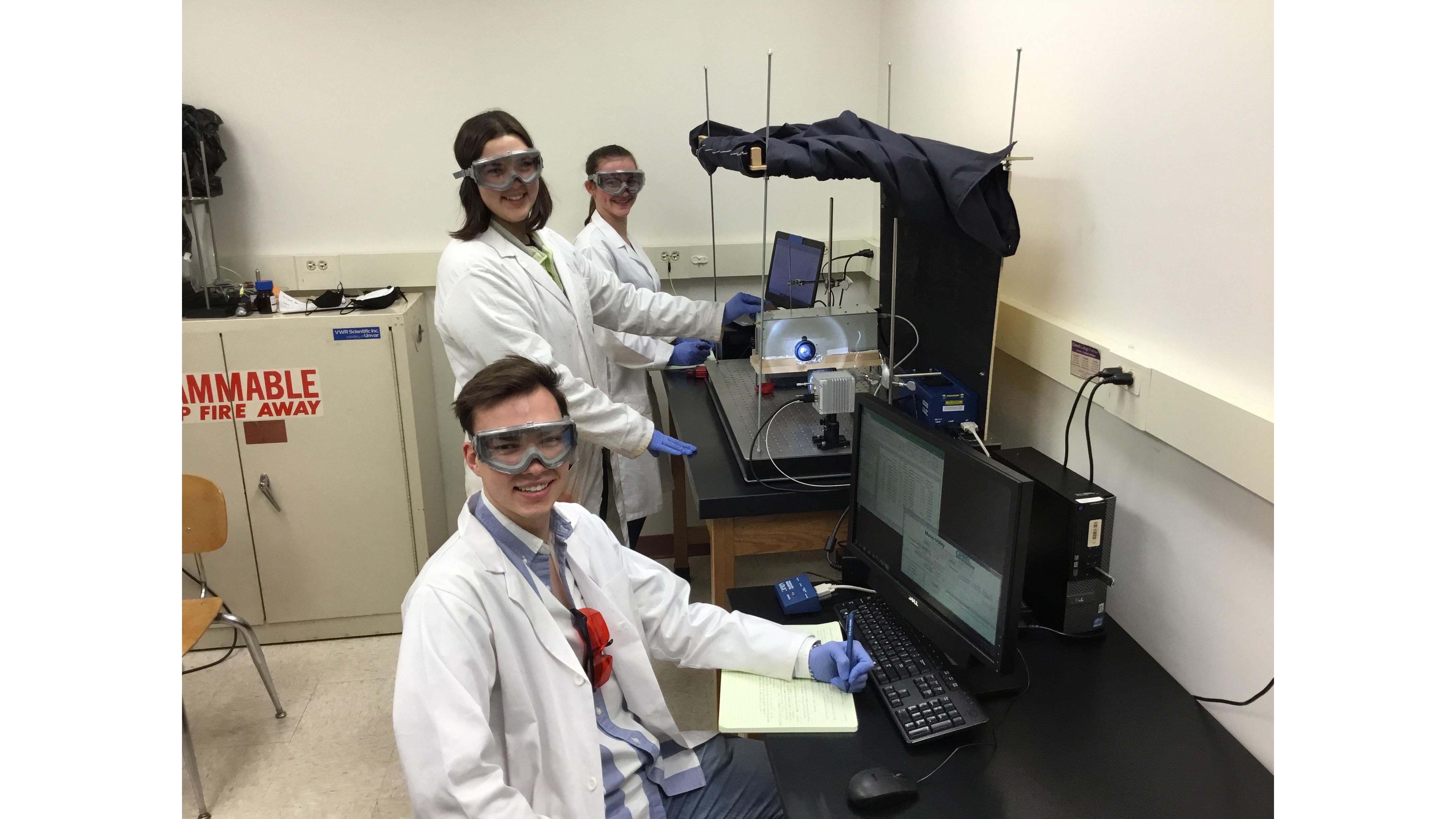Pictured front to back: Tim Radosevich, Maggie Bailey, Elliot Wald
HELENA, MT – Carroll College students explored how “Martian blueberries” may potentially generate electricity on Mars. Their research, recently published in a respected aerospace and systems engineering magazine, demonstrates how these mineral formations could be used to build solar panels directly on the Martian surface.
The “blueberries,” hematite spherules first discovered in 2004 by NASA’s Mars Exploration Rover Opportunity, provided important geological clues about the history of water on Mars. Now, Carroll student researchers are showing they may also serve as a raw material for energy production.
“The long-term goal of this NASA-funded research is to support space exploration by developing strategies to generate electricity on Mars. In the paper, we demonstrate one method of fabricating solar panels from minerals already present on the Martian surface, thus avoiding the need to transport heavy materials from Earth,” said Dr. John Rowley, associate professor of chemistry at Carroll College.
The peer-reviewed article, “Solar cells fabricated from minimally processed hematite sources similar to those on the Martian surface,” was published in the July 2025 issue of IEEE Aerospace and Electronic Systems Magazine. The research was conducted by three Carroll undergraduates under the mentorship of Professor Rowley. Their paper details how to fabricate solar cells using three different iron-containing minerals similar to those found on Mars.
These proof-of-concept solar cells have low efficiency but could provide an alternative strategy for generating electricity. The light-absorbing components of this technology could be fabricated easily and rapidly from minimally processed resources available on the Martian surface.
Over two summers, the students worked full-time in the lab, mastering advanced technical skills, learning to operate chemical instrumentation, and ultimately presenting their results at national conferences. Their accomplishments included winning major research awards, with Elliot Wald ‘24 receiving the 2023 John Van Zytveld Award in the Physical Sciences at the Murdock College Science Research Conference and the team earning a poster prize at the American Chemical Society Western Conference. They also contributed to a peer-reviewed article, an extraordinary achievement for undergraduate students.
“This opportunity taught me how to approach open-ended scientific problems with creativity and persistence. I learned to adapt when experiments didn’t go as planned and gained a deeper appreciation for the iterative nature of scientific discovery. Working with Professor Rowley solidified my interest in science and research, showing me how fundamental research can lead to real-world applications. I’m incredibly grateful for the mentorship and teamwork that made this project possible—it played a key role in shaping my career path,” said Maggie Bailey, class of 2023 and currently a biochemistry PhD candidate at Montana State University.
Student co-author Elliot Wald, class of 2024, now a graduate research assistant and neuroscience PhD candidate at Washington State University, reflected on the impact of the experience: “The opportunity to work in Professor Rowley’s lab helped me discover that scientific research is a complex but rewarding endeavor. Even on days when progress isn’t linear, you know that asking the next question will cause something new to happen! Perseverance is arguably more important than the knowledge you have going into a project because you will be learning throughout the entire process. Working with Professor Rowley, Maggie, and Tim solidified my love of research and guided me towards pursuing a graduate degree in neuroscience.”
The third co-author, Tim Radosevich, class of 2023 and now a medical student at the University of Washington, added, “This research laid the groundwork for my current endeavors. I’ve come to view medical school as a big experiment on oneself—one that demands fast-paced learning, heightened empathy, the exploration of difficult and philosophical questions, and the development of leadership skills. Through my mentoring and work on this project, I gained invaluable skills in systematic data recording, drawing conclusions, and implementing small yet meaningful changes based on my findings. These experiences have helped me effectively reflect on myself as a student and future practitioner, guiding my transition and growth.”
The research also underscores Carroll College’s mission to provide transformative learning experiences for students, both in and out of the classroom. “This publication reflects Carroll College’s deep commitment to hands-on undergraduate research,” said Dr. Jennifer Glowienka, interim co-president of Carroll College. “Our students are not only contributing to science but gaining skills that set them apart in graduate school, medical school, and beyond. It is inspiring to see how their curiosity and perseverance lead to discoveries with real-world impact.”
Read the full research publication at: https://ieeexplore.ieee.org/document/10914523. To learn more about Carroll College’s chemistry, biology, or biochemistry & molecular biology programs and opportunities for undergraduate research, visit www.carroll.edu.

